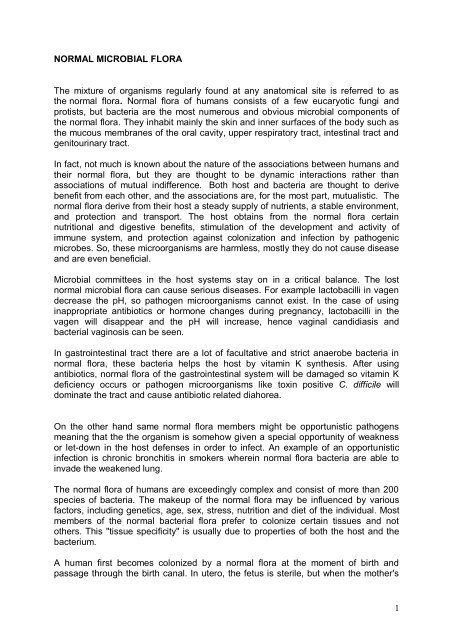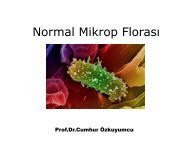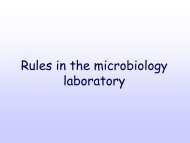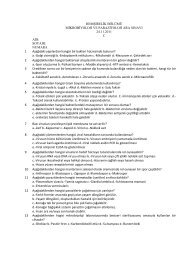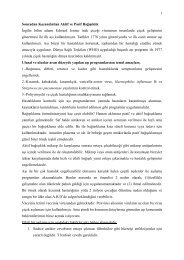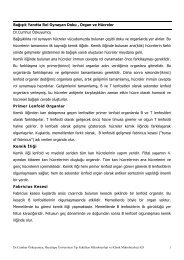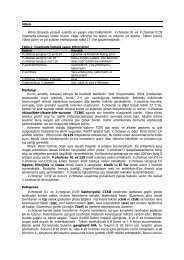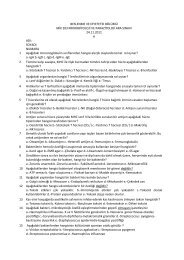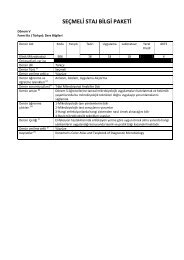NORMAL MICROBIAL FLORA
NORMAL MICROBIAL FLORA
NORMAL MICROBIAL FLORA
You also want an ePaper? Increase the reach of your titles
YUMPU automatically turns print PDFs into web optimized ePapers that Google loves.
<strong>NORMAL</strong> <strong>MICROBIAL</strong> <strong>FLORA</strong><br />
The mixture of organisms regularly found at any anatomical site is referred to as<br />
the normal flora. Normal flora of humans consists of a few eucaryotic fungi and<br />
protists, but bacteria are the most numerous and obvious microbial components of<br />
the normal flora. They inhabit mainly the skin and inner surfaces of the body such as<br />
the mucous membranes of the oral cavity, upper respiratory tract, intestinal tract and<br />
genitourinary tract.<br />
In fact, not much is known about the nature of the associations between humans and<br />
their normal flora, but they are thought to be dynamic interactions rather than<br />
associations of mutual indifference. Both host and bacteria are thought to derive<br />
benefit from each other, and the associations are, for the most part, mutualistic. The<br />
normal flora derive from their host a steady supply of nutrients, a stable environment,<br />
and protection and transport. The host obtains from the normal flora certain<br />
nutritional and digestive benefits, stimulation of the development and activity of<br />
immune system, and protection against colonization and infection by pathogenic<br />
microbes. So, these microorganisms are harmless, mostly they do not cause disease<br />
and are even beneficial.<br />
Microbial committees in the host systems stay on in a critical balance. The lost<br />
normal microbial flora can cause serious diseases. For example lactobacilli in vagen<br />
decrease the pH, so pathogen microorganisms cannot exist. In the case of using<br />
inappropriate antibiotics or hormone changes during pregnancy, lactobacilli in the<br />
vagen will disappear and the pH will increase, hence vaginal candidiasis and<br />
bacterial vaginosis can be seen.<br />
In gastrointestinal tract there are a lot of facultative and strict anaerobe bacteria in<br />
normal flora, these bacteria helps the host by vitamin K synthesis. After using<br />
antibiotics, normal flora of the gastrointestinal system will be damaged so vitamin K<br />
deficiency occurs or pathogen microorganisms like toxin positive C. difficile will<br />
dominate the tract and cause antibiotic related diahorea.<br />
On the other hand same normal flora members might be opportunistic pathogens<br />
meaning that the the organism is somehow given a special opportunity of weakness<br />
or let-down in the host defenses in order to infect. An example of an opportunistic<br />
infection is chronic bronchitis in smokers wherein normal flora bacteria are able to<br />
invade the weakened lung.<br />
The normal flora of humans are exceedingly complex and consist of more than 200<br />
species of bacteria. The makeup of the normal flora may be influenced by various<br />
factors, including genetics, age, sex, stress, nutrition and diet of the individual. Most<br />
members of the normal bacterial flora prefer to colonize certain tissues and not<br />
others. This "tissue specificity" is usually due to properties of both the host and the<br />
bacterium.<br />
A human first becomes colonized by a normal flora at the moment of birth and<br />
passage through the birth canal. In utero, the fetus is sterile, but when the mother's<br />
1
water breaks and the birth process begins, so does colonization of the body surfaces.<br />
Handling and feeding of the infant after birth leads to establishment of a stable<br />
normal flora on the skin, oral cavity and intestinal tract in about 48 hours.<br />
Resident flora: Consist of relatively fixed types of microorganisms regularly found in<br />
a given area at a given age. Resident flora promptly reestablishes itself if disturbed.<br />
Transient flora: Consist of non-pathogenic or potentially pathogenic microorganisms<br />
that inhabit the mucous membranes for hours, days, weeks. Members of the transient<br />
flora are derived from the environment and they are not establish themselves<br />
permenantly on the surfaces. They can not cause infectious diseases if resident flora<br />
remains intact.<br />
Normal flora of the skin:<br />
Several factors such as dryness, low pH, inhibitory substances (lysozyme from sweat<br />
glands and toxic fatty acids from sebaceous glands) are responsible for discouraging<br />
skin colonization. Staphylococcus species do compose 90% of aerobic members of<br />
normal skin flora. Anaerobic diphteroids inhabit deeper layers of skin.<br />
Normal flora of respiratory tract:<br />
Mouth: Continous flow of saliva exerts a mechanical flushing action that removes<br />
many microorganisms. Until eruption of teeth, most microorganisms in oral cavity are<br />
aerobes and facultative anaerobes. As the first tooth appears, obligate anaerobes<br />
become more evident as the tissue surrounding the teeth provides an anaerobic<br />
environment. Streptococcus mutans is a member of normal oral flora and appears to<br />
be the major ethiological agent of dental caries.<br />
Upper respiratory tract: Through inhalation, air containing microorganisms pass<br />
through nasal passages and nasopharynx, microorganisms stick to the thin moisty<br />
layer of highly viscous mucus that overlies these surfaces. Mucus also contains<br />
bactericidal enzyme, lysozyme. In additon, rythmic beating of ciliar epithelial cells of<br />
upper respiratory tract drives microorganisms through pharynx. Nose and<br />
nasopharynx are inhabited by many microorganisms despite those mechanisms.<br />
A large number of bacterial species colonize upper respiratory tract (nasopharynx).<br />
Nostrils are always heavily colonized, predominantly with Staphylococcus<br />
epidermidis and Corynebacteria, and often (in about 20% of the general population)<br />
with Staphylococcus aureus, this being the main carrier site of this important<br />
pathogen.<br />
Staphylococci are the main habitants of the nose. Other normal flora members of<br />
nasopharynx are to be Streptococcus, Neisseria and Haemophilus species.<br />
Lower respiratory tract: Trachea and bronchi do not have a normal flora due to ciliadriven<br />
mucus flow. The lower respiratory tract (trachea, bronchi and pulmonary<br />
tissues) is virtually free of microorganisms, mainly because of the efficient cleansing<br />
action of the ciliated epithelium which lines the tract. Any bacteria reaching the lower<br />
2
espiratory tract are swept upward by the action of the mucociliary blanket that lines<br />
the bronchi, to be removed subsequently by coughing, sneezing, swallowing, etc<br />
Normal flora of gastrointestinal tract:<br />
In the upper gastrointestinal tract of adult humans, the esophagus contains only the<br />
bacteria swallowed with saliva and food. Because of the high acidity of the gastric<br />
juice, very few bacteria (mainly acid-tolerant lactobacilli) can be cultured from the<br />
normal stomach.<br />
Duodenum has less than 1000 bacteria/ml which are mostly Gram (+) cocci and<br />
bacilli. In jejunum, few enterococci, lactobacilli and diphteroids may be present. In<br />
ileum the flora resembles that of the large intestine. The flora of the large intestine<br />
(colon) is qualitatively similar to that found in feces. Anaerobic bacteria and members<br />
of the family Enterobactericeae appear in large numbers. 95-99 % of normal flora in<br />
colon are anaerobes.<br />
The other members are Gram (+) bacilli, enteric bacteria and the yeast Candida.<br />
Normal flora of intestine can be influenced by various factors such as stress,<br />
starvation, antibiotic therapy and diet.<br />
Normal flora of genitourinary tract:<br />
In a healthy person kidneys, urinary bladder and ureters are free of microorganisms.<br />
However, bacteria are commonly found in the lower portion of both male and female<br />
urethra. Usually, streptococci and diphteroids may be found in urethra. In females<br />
vagina has a very complex normal flora. Its composition would change according to<br />
the age. Before puberty the predominant organisms are stapylococci, streptococci,<br />
diphteroids and E. coli. In adult vagina main inhabitants are acid-tolerant<br />
lactobacillus, which breakdown glycogen, forming acid. As a result the pH of vagina<br />
is 4.4-4.6 and this prevents overgrowth of other microorganisms. he resulting low pH<br />
of the vaginal epithelium prevents establishment by most other bacteria as well as<br />
the potentially-pathogenic yeast, Candida albicans. This is a striking example of the<br />
protective effect of the normal bacterial flora for their human host.<br />
3


